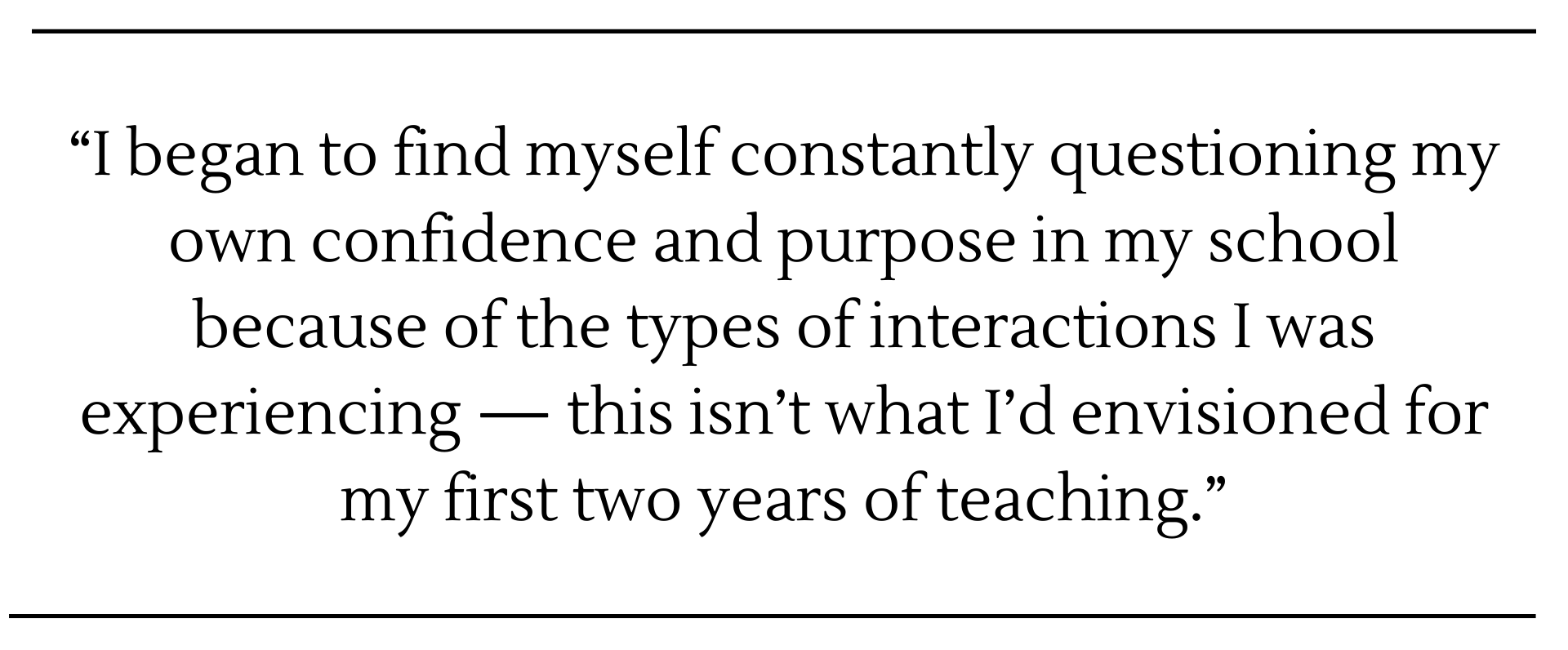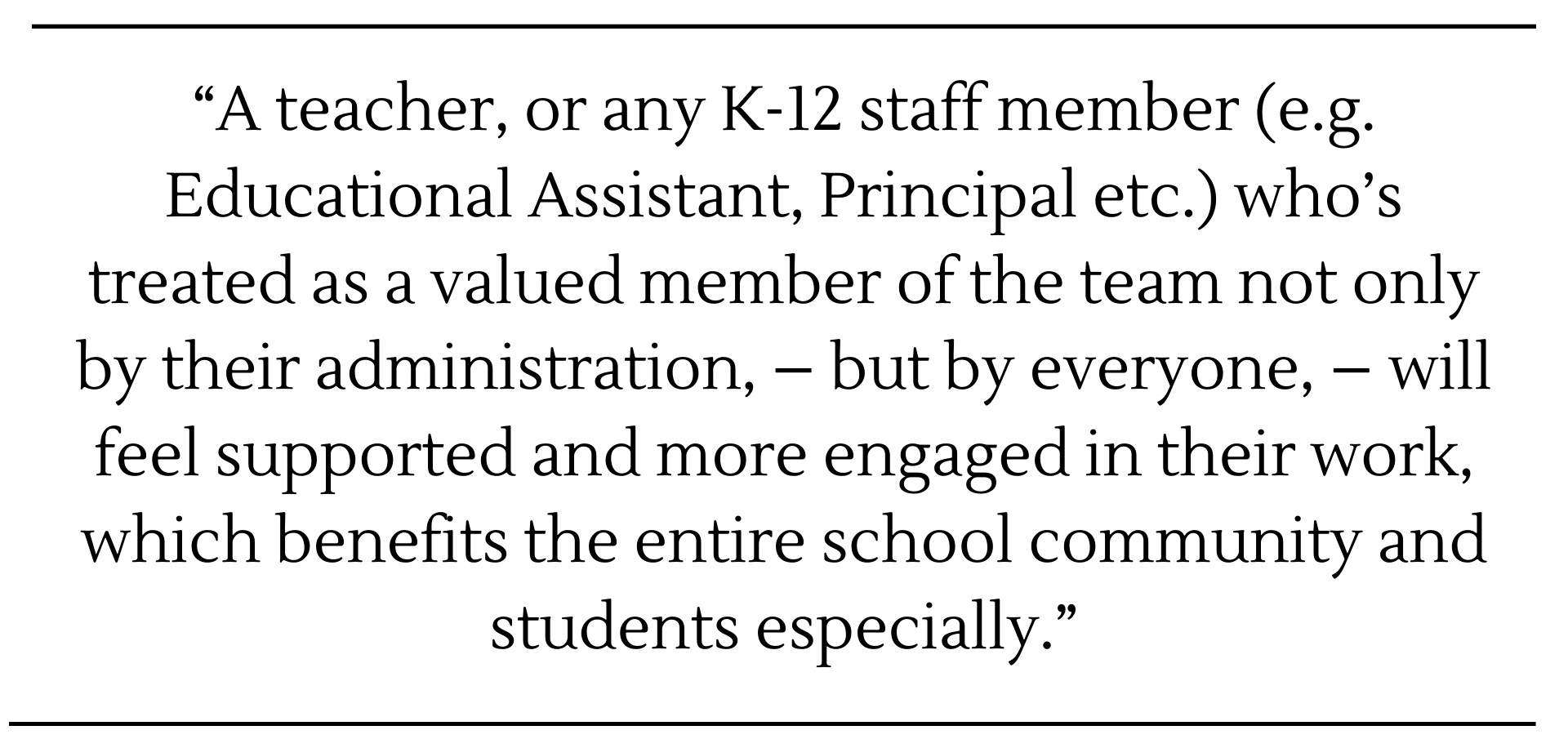Dealing with a negative school environment as a new teacher
How I’m learning more about the importance of strong teacher-administrator relationships and building up my own resilience
IN BEGINNING MY JOURNEY AS A TEACHER, I LEARNED THAT I HAD TO BETTER UNDERSTAND TEACHER WELL-BEING IN TODAY’S K-12 EDUCATION SYSTEMS.
When I began teaching, I decided to enroll in the Master’s of Professional Education program (M.P.Ed.) at Western University, with a focus on Curriculum and Pedagogy. To me, this was an easy decision given that the practicum placements I undertook during my pre-service teaching program had ultimately left me with more questions than answers about current policies and initiatives to support teacher well-being. From my experience, the majority of education policies and initiatives that are publicly available remain largely focused on student well-being and on how teachers can make various changes to their professional practice to inspire student success. I began to wonder, “Why are there such limited documents and resources available that focus on the value of teacher well-being and that show how teachers’ levels of well-being directly influence their professional practice? How are teachers supposed to support student well-being and success, if their own well-being isn’t supported by K-12 education systems?”

It’s these types of questions that led me to conduct research during my M.P.Ed. program specifically on the value of teachers in today’s classrooms. As I began to scan the available research on K-12 teacher well-being in schools across Canada, I was able to confirm that there indeed wasn’t much research available that actually looked at the well-being of teachers. As a full-time student simultaneously teaching full-time, what I was finding through my research was backed not only by my personal experiences but by many of the conversations I had with fellow colleagues at the very first school I was teaching at. Ultimately, I began to notice that many of the stories I was hearing all had an underlying commonality — that teachers’ well-being was almost always linked to the quality of relationship teachers have with their school principals.

TEACHERS AND PRINCIPALS: WHY BUILDING UP THIS RELATIONSHIP IS SO IMPORTANT.
Emotional exhaustion including low energy and consistent fatigue caused by workload or time pressure, fear of speaking honestly, and other professional frustrations are warning signs that teachers may be trailing along a path towards burnout. Much of the research that’s been offered in the past 5-to-10 years hints that negative school climate and classroom environments can take a toll on a person’s ability to teach effectively. Part of what can help create a healthier school climate is the quality of teacher-principal relationships, and we know that negative relationships between professionals can negatively affect the quality of instructional leadership and learning taking place within a school.

After graduating from my pre-service program, I landed a full-time French Immersion teaching position in a school where I soon realized there was a consistent lack of open and positive communication between the staff team and administrative team. When trying to learn about how things worked in my school, as well as navigate what was expected of me, I often received different answers depending on who I asked. If I posed questions to other staff members, I’d get responses like, “I’m not sure…”, “I don’t know…”, “I think so and so knows that answer…”, and, “I think the admin said this, but I would go and ask them to make sure…” I began to find myself constantly questioning my own confidence and purpose as a teacher because of the lack of trust and clarity I was often experiencing in my interactions with administrative staff. This isn’t at all what I’d envisioned for my first two years of teaching.

As someone who had learned, while training as a teacher in university, the importance of maintaining open lines of communication between myself and school administration, I began to realize that this simply wasn’t a case of me being unprepared as a new teacher. More importantly, I knew I wasn’t alone in experiencing these communication problems. Over time, as much I would try to remind myself that my mental, emotional, and physical well-being were important to maintain in my profession, I became more and more discouraged each morning I returned to school. It became clear to me that the lack of clear communication between staff and administration, among other things, weren’t conducive to building a healthy, supportive school culture. It was also clear that this was taking a toll on everyone’s well-being. If I was dreading going to work, I’m sure both other staff and administration were, too. I knew for the sake of my own well-being, and that of my colleagues and administrators, that none of us could continue working in an environment like this. I was left wondering, “What steps could we all be taking to improve workplace satisfaction and the overall well-being of all K-12 staff?”
THE TAKEAWAY: NOT ALL HOPE IS LOST WHEN IT COMES TO ENSURING HIGH QUALITY TEACHER-PRINCIPAL RELATIONSHIPS AND RESTORING THE VALUE OF ALL TEACHERS.
My experiences during my first two years as a teacher were very eye-opening and served as a great learning experience in how relationships are so key to well-being in the workplace. A teacher, or any K-12 staff member (e.g. Educational Assistant, Principal, etc.) who’s treated as a valued member of the team not only by their administration – but by everyone – will feel supported and more engaged in their work, which benefits the entire school community and students especially.
Through experience and further research, I hope to be able to find some answers and solutions to the problems associated with strained teacher-principal relationships. Far too many teachers and principals today are experiencing unnecessary levels of anxiety, confusion, uncertainty, and a low sense of well-being. My best advice for those who are also in their beginning years of the profession is to find strategies to build up your resilience at work and, most especially, to trust yourself. By reminding ourselves to follow our instincts on both personal and professional levels, we as teachers can build and maintain a sense of value and purpose in our important roles.

Photos: Adobe Stock
check out the following resources to learn more about:
1. Empowering Modern Educators
This resource has been created to encourage and empower all educators. Much of the information presented in this resource is solely meant to highlight some of the major, and ongoing challenges that are experienced daily by educators. This resource is also meant to give educators the confidence to maintain the difficult, but necessary, dialogue about the added responsibilities and stresses which this profession, at times, places on us.
Learn more here
2. Restoring the Value of Teachers: A Perspective on Quality Teacher-Principal Relationships
A compilation of research that examines what makes a quality teacher-principal relationship.
